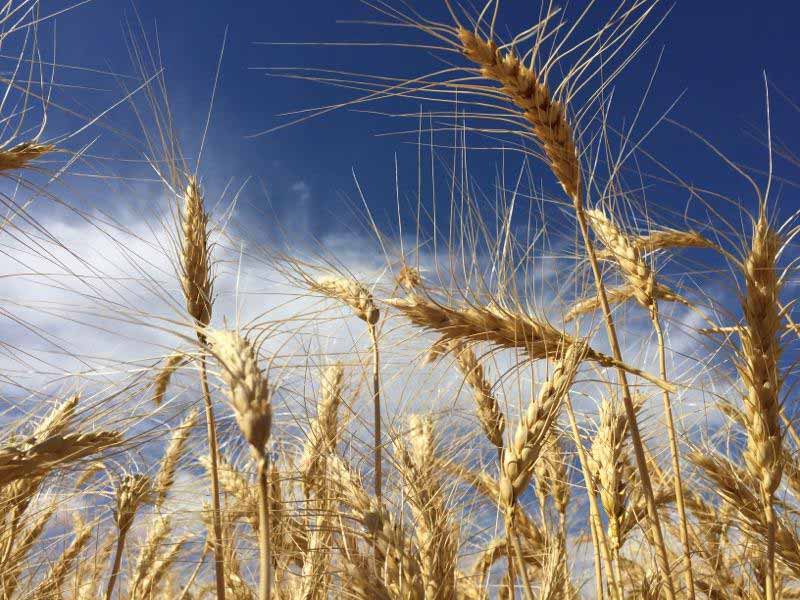Wheat Grading Characteristics
The Federal Grain Inspection Service (FGIS) of the USDA Grain Inspection, Packers and Stockyards Administration (GIPSA) sets the standard for U.S. grain grades and grade requirements. U.S. grain grades are reflective of the general quality and condition of a representative sample of U.S. wheat. These grades are based on characteristics such as test weight and include limits on damaged kernels, foreign material, shrunken and broken kernels, and wheat of contrasting classes. Each determination is made on the basis of the grain free of dockage. Grades issued under U.S. standards represent a sum of these factors.
Wheat Grading Data

Each determination of heat-damaged kernels, damaged kernels, foreign material, wheat of other classes, contrasting classes, and subclasses is made
on the basis of the grain when free from dockage and shrunken and broken kernels.
- Defects are damaged kernels, foreign materials, and shrunken and broken kernels. The sum of these three factors may not exceed the limit for the factor defects for each numerical grade.
- Foreign material is all matter other than wheat that remains in the sample after the removal of dockage and shrunken and broken kernels.
- Shrunken and broken kernels are all matter that passes through a 0.064 x 3/8-inch oblong-hole sieve after sieving according to procedures prescribed in the FGIS instructions.
- Damaged kernels are kernels, pieces of wheat kernels, and other grains that are badly ground-damaged, badly weather-damaged, diseased, frost-damaged, germ-damaged, heat-damaged, insect-bored, mold-damaged, sprout-damaged, or otherwise materially damaged.
- Test Weight is a measure of the density of the sample and may be an indicator of milling yield and the general condition of the sample, as problems that occur during the growing season or at harvest often reduce test weight.
Other Wheat Characteristics
In addition to the U.S. grade factors, there are other characteristics at work to determine the value of the wheat. Examples include dockage, wheat moisture, wheat protein content, thousand-kernel weight (TKW), and falling number.
- Moisture content is an indicator of grain condition and storability. Wheat or flour with low moisture content is more stable during storage. Moisture content is often standardized (12% or 14% moisture basis) for other tests that are affected by moisture content.
- Protein content relates to many important processing properties, such as water absorption and gluten strength, and finished product attributes such as texture and appearance. Higher-protein dough usually absorbs more water and takes longer to mix. Hard Red Winter (HRW) wheat generally has a medium- to high-protein content, making it most suitable for all-purpose flour and chewy-texture breads.
- Ash content also indicates milling performance and how well the flour separates from the bran. Millers need to know the overall mineral content of the wheat to achieve desired or specified ash levels in flour. Ash content can affect flour color. White flour has low ash content, which is often a high priority among millers.
- Thousand-kernel weight and kernel diameter provide measurements of kernel size and density important for milling quality. Simply put, it measures the mass of the wheat kernel. Millers tend to prefer larger berries or at least berries with a consistent size. Wheat with a higher TKW can be expected to have a greater potential flour extraction.
- Falling number is an index of enzyme activity in wheat or flour and is expressed in seconds. Falling numbers above 300 are desirable, as they indicate little enzyme activity and a sound, quality product. Falling numbers below 300 are indicative of more substantial enzyme activity and sprout damage.
- Dockage is all matter other than wheat that can be removed from the original sample by use of an approved device according to procedures prescribed in FGIS instructions.
- Kernel size is a measure of the percentage by weight of large, medium, and small kernels in a sample. Large kernels or more uniform kernel size may help improve milling yield.
- Single Kernel Characterization System (SKCS) measures 300 individual kernels from a sample for size (diameter), weight, hardness (based on the force needed to crush), and moisture.